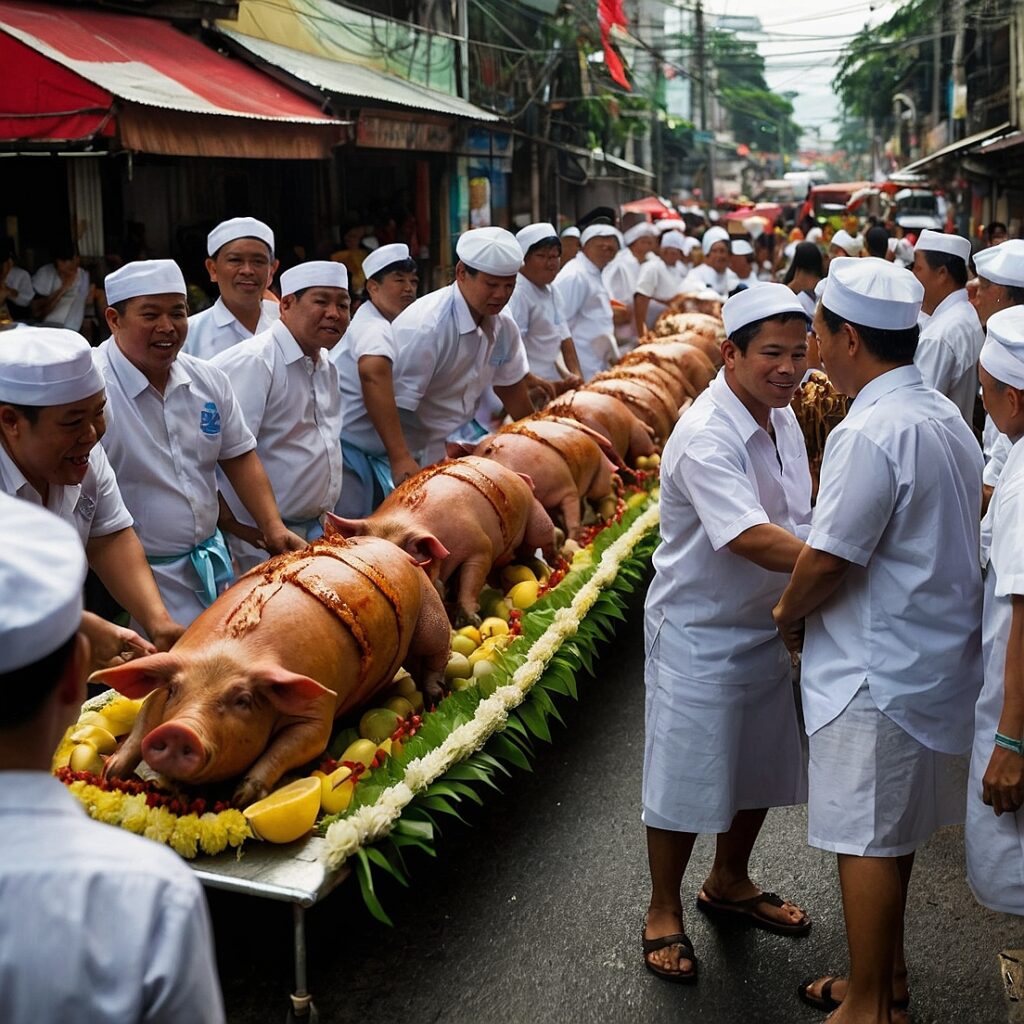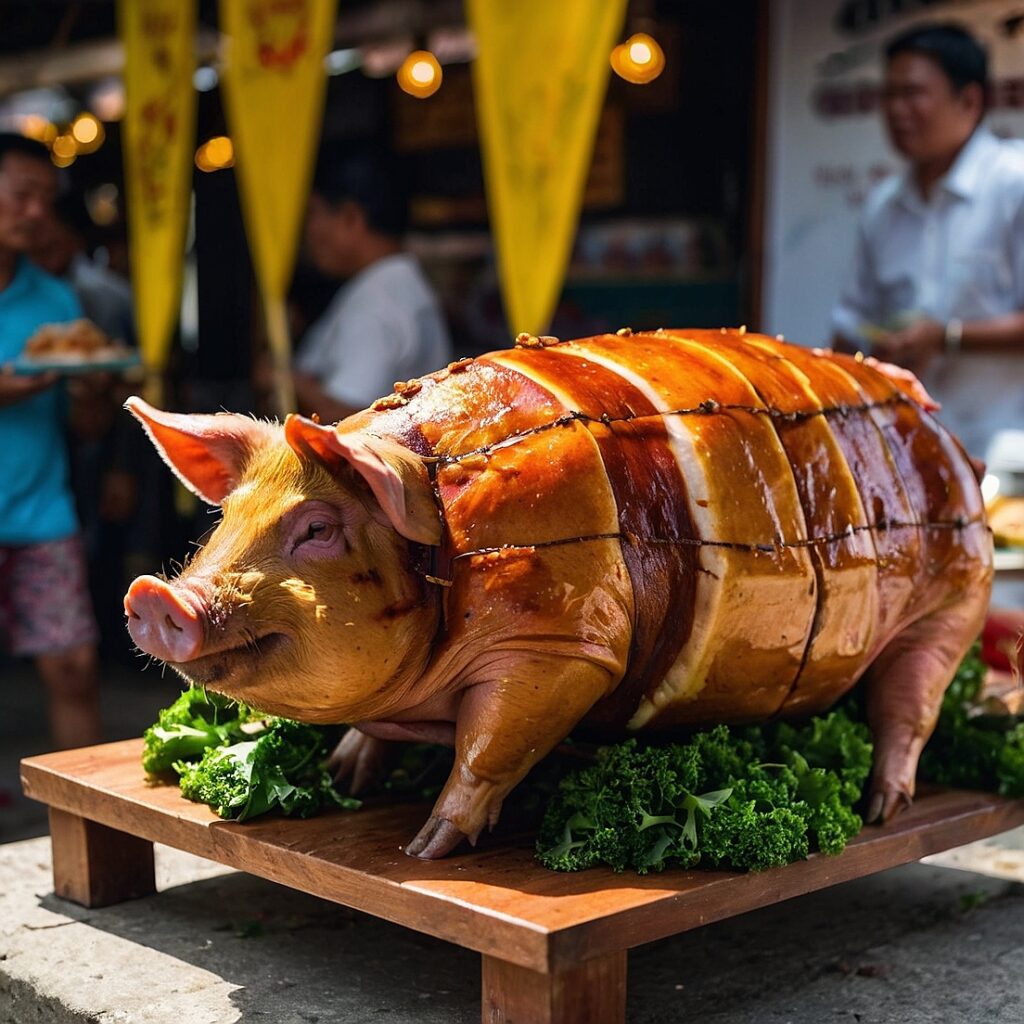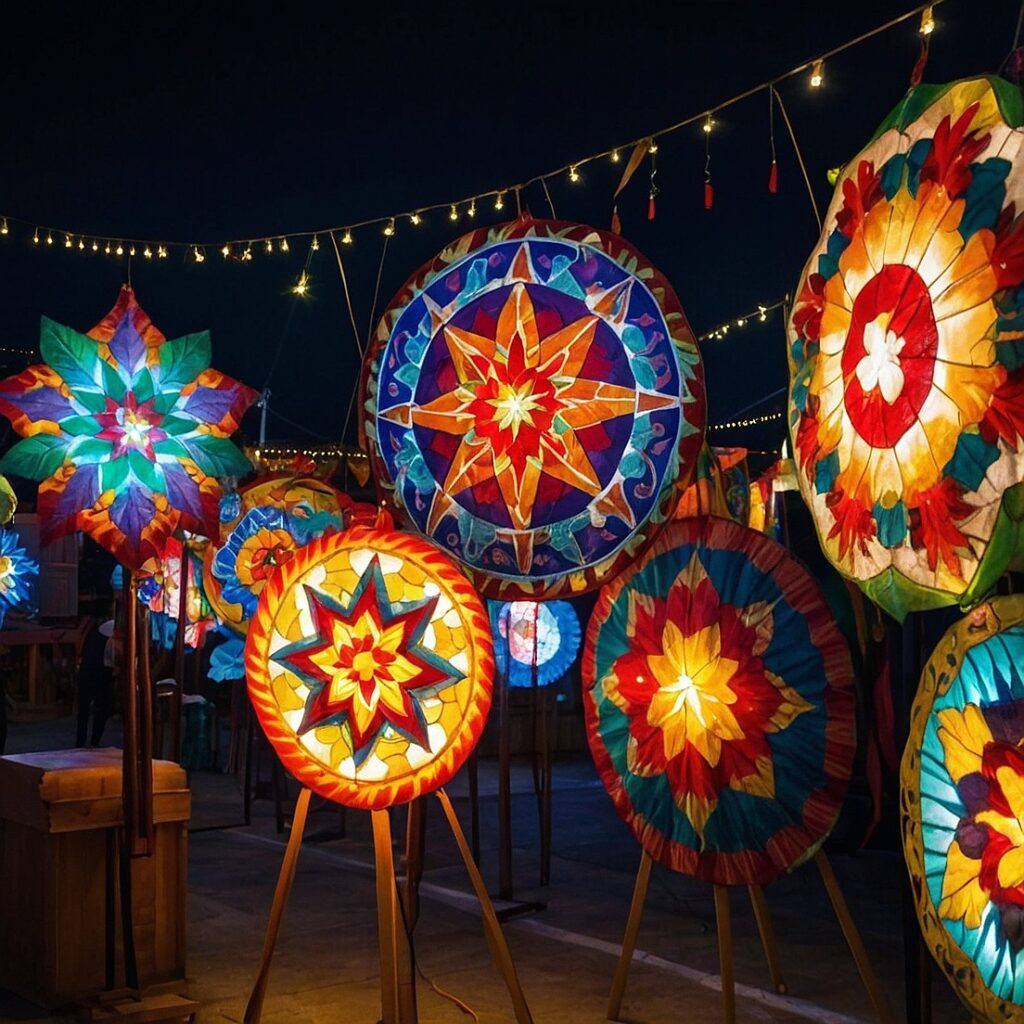Have you ever wondered what it would be like to attend a festival where the star of the show is a succulent, crispy-skinned roasted pig? Well, wonder no more! Let me take you on a journey to the charming town of Balayan in Batangas, Philippines, where the annual Lechon Festival takes center stage every June 24th. This isn’t just any ordinary food festival; it’s a grand celebration that combines religious devotion, cultural heritage, and of course, an abundance of mouthwatering lechon (roasted pig) that will make your taste buds dance with joy.
The Lechon Festival, also known as the Parada ng Lechon, is a unique and flavorful event that has been captivating locals and tourists alike for decades. Imagine streets lined with hundreds of perfectly roasted pigs, their golden-brown skin glistening in the sun, ready to be paraded and then devoured by eager festival-goers. It’s a sight that’s sure to make any food lover’s heart skip a beat! But there’s so much more to this festival than just indulging in delicious pork. Let’s dive deeper into the rich history, vibrant traditions, and exciting activities that make the Lechon Festival a must-visit event for anyone looking to experience the true flavor of Filipino culture.
The Roots of the Roast: History and Significance
A Tradition Steeped in Faith
The Lechon Festival isn’t just about satisfying our carnivorous cravings; it has deep historical and religious roots that date back centuries. The celebration coincides with the Feast of St. John the Baptist, the patron saint of Balayan. This connection between faith and food is a testament to the Filipino people’s ability to blend their religious beliefs with their love for festivities and good eats. The tradition of roasting pigs for this occasion is said to have started in the 1970s when a local family decided to celebrate the feast day by preparing lechon and sharing it with their neighbors. What began as a small, neighborly gesture soon grew into a town-wide phenomenon, capturing the hearts (and stomachs) of the entire community.
From Humble Beginnings to Grand Celebration
As the years passed, more and more families joined in the tradition, and the number of lechons prepared for the feast day increased exponentially. The local government took notice of this growing trend and saw an opportunity to showcase Balayan’s hospitality and culinary expertise. In 1989, the town officially organized the first Parada ng Lechon, turning what was once a simple family tradition into a full-blown festival that would put Balayan on the map as a must-visit destination for food enthusiasts and cultural explorers alike. Since then, the festival has continued to grow in size and popularity, attracting visitors from all over the Philippines and even from other countries.
The Feast of Flavors: What to Expect at the Lechon Festival
A Parade Like No Other
The highlight of the Lechon Festival is undoubtedly the grand parade of roasted pigs. Picture this: hundreds of perfectly cooked lechons, each weighing between 30 to 50 kilograms, being paraded through the streets of Balayan. These culinary masterpieces aren’t just carried on plain old floats; oh no, the townspeople go all out in decorating their lechon-bearing vehicles. You’ll see everything from traditional Filipino-themed floats to more whimsical and creative designs that showcase the town’s artistic flair. It’s not uncommon to spot lechons dressed up in costumes or even positioned in humorous poses, adding an element of fun and laughter to the already festive atmosphere.
A Feast for the Senses
As you watch the parade go by, your senses will be overwhelmed in the best possible way. The aroma of roasted pork fills the air, mingling with the scent of various herbs and spices used in the cooking process. The sound of lively music and cheering crowds creates an electric atmosphere that’s impossible to resist. And let’s not forget the visual spectacle of the beautifully bronzed lechons, their crispy skin practically begging to be crackled and savored. It’s a multisensory experience that truly captures the essence of Filipino festivity and culinary pride.
More Than Just Lechon
While the roasted pigs are undoubtedly the stars of the show, the Lechon Festival offers so much more for attendees to enjoy. Throughout the day, you’ll find various activities and contests that showcase the town’s talents and traditions. These may include:
- Lechon-eating contests (for those with hearty appetites)
- Cultural performances featuring traditional Filipino dances and music
- Art exhibitions showcasing local artists’ works
- Cooking demonstrations where you can learn the secrets of perfect lechon preparation
- Street games and activities for children and adults alike
The festival is a perfect blend of gastronomic indulgence and cultural immersion, offering something for everyone, whether you’re a foodie, a culture enthusiast, or simply looking for a unique and memorable experience.
The Art of Lechon: Crafting the Perfect Roasted Pig
A Labor of Love
Creating the perfect lechon is no small feat; it’s a labor of love that requires skill, patience, and a deep understanding of the culinary arts. The process begins long before the actual roasting, with the selection of the pig. Balayan’s lechoneros (lechon makers) take great pride in choosing pigs that are just the right size and have the ideal fat-to-meat ratio to ensure a juicy and flavorful end result.
The Preparation Process
Once the pig is selected, the real work begins. Here’s a general overview of the steps involved in preparing a traditional Balayan lechon:
- Cleaning and preparation: The pig is thoroughly cleaned inside and out.
- Seasoning: A mixture of herbs, spices, and aromatics is prepared and stuffed into the pig’s cavity. Common ingredients include lemongrass, garlic, onions, and various local herbs.
- Trussing: The pig is carefully sewn up and tied to maintain its shape during roasting.
- Basting: A special mixture is prepared for basting the pig throughout the cooking process to ensure a crispy, golden-brown skin.
- Roasting: The pig is slowly roasted over hot coals for several hours, often requiring a team of people to rotate the spit and maintain the fire.
The entire process can take anywhere from 4 to 6 hours, depending on the size of the pig and the desired level of doneness. It’s a time-consuming endeavor, but ask any lechonero, and they’ll tell you it’s well worth the effort when you see (and taste) the final result.
The Secret to Crispy Skin
One of the most prized aspects of a well-made lechon is its crispy, crackling skin. Achieving this perfect texture is an art form in itself. Balayan’s lechoneros have perfected techniques passed down through generations to ensure that every lechon has that signature crunch. Some of their secrets include:
- Carefully controlling the heat during roasting
- Strategically basting the pig with a mixture that often includes soy sauce, vinegar, and various spices
- Massaging the pig’s skin with oil and salt before roasting
- Adjusting the distance between the pig and the heat source throughout the cooking process
These techniques, combined with years of experience and a keen eye for detail, result in the crispy, golden-brown skin that lechon lovers crave.
The Lechon Economy: Impact on Balayan’s Community
Boosting Local Businesses
The Lechon Festival isn’t just a treat for the taste buds; it’s also a significant economic driver for Balayan. The annual event brings a surge of visitors to the town, creating opportunities for local businesses to thrive. Hotels, restaurants, souvenir shops, and transportation services all see a significant uptick in business during the festival period. This influx of tourists helps to sustain the local economy and provides income for many families in the community.
Employment Opportunities
The preparation for the Lechon Festival creates numerous temporary and permanent job opportunities for Balayan’s residents. From lechoneros and their assistants to float decorators, event organizers, and security personnel, the festival requires a small army of workers to ensure its success. This not only provides immediate economic benefits but also helps to preserve traditional skills and crafts associated with lechon-making and festival organization.
Promoting Local Agriculture
The demand for high-quality pigs for the festival has a positive impact on local pig farmers. Many lechoneros prefer to source their pigs from local farms, supporting the agricultural sector in Balayan and surrounding areas. This symbiotic relationship between the festival and local agriculture helps to maintain the quality of the lechons while also supporting sustainable farming practices in the region.
Here’s a table summarizing the economic impact of the Lechon Festival on Balayan (based on estimates up to 2021):
| Economic Aspect | Impact |
|---|---|
| Annual Visitors | 50,000 – 70,000 |
| Revenue Generated | ₱15 – 20 million |
| Temporary Jobs Created | 500 – 700 |
| Participating Local Businesses | 200 – 250 |
| Lechons Prepared | 300 – 400 |
Preserving Tradition in a Changing World
Challenges Facing the Festival
While the Lechon Festival continues to be a beloved tradition in Balayan, it’s not without its challenges. In recent years, concerns about health, sustainability, and animal welfare have led to some questioning the future of such meat-centric celebrations. Additionally, the COVID-19 pandemic forced organizers to adapt and find new ways to celebrate while ensuring public safety.
Adapting to Modern Times
Despite these challenges, the people of Balayan have shown remarkable resilience and creativity in preserving their cherished tradition. Some of the ways the festival has evolved include:
- Introducing vegetarian and plant-based alternatives to cater to changing dietary preferences
- Implementing stricter hygiene and food safety measures
- Exploring virtual and socially-distanced celebration options during the pandemic
- Emphasizing sustainable and ethical sourcing of pigs for the festival
These adaptations demonstrate the community’s commitment to maintaining their cultural heritage while also addressing contemporary concerns and challenges.
Beyond the Festival: Exploring Balayan
A Town Rich in History and Culture
While the Lechon Festival may be the main attraction, Balayan has so much more to offer visitors. The town boasts a rich history dating back to the Spanish colonial era, evident in its well-preserved architecture and historical sites. Some must-visit locations include:
- The Balayan Church (Immaculate Conception Parish Church): A stunning example of baroque architecture, built in the 17th century
- Ermita Park: A lovely green space perfect for picnics and relaxation
- Casa Segunda: A heritage house that offers a glimpse into the town’s colonial past
Natural Beauty and Outdoor Adventures
For those who love nature and outdoor activities, Balayan doesn’t disappoint. The town is blessed with beautiful beaches, lush forests, and scenic countryside. Visitors can enjoy:
- Beach hopping along the coast
- Hiking in nearby mountains
- Exploring mangrove forests
- Visiting local farms and experiencing rural Filipino life
These attractions make Balayan an ideal destination for those looking to extend their stay beyond the Lechon Festival and truly immerse themselves in the local culture and natural beauty of the region.
Tips for Attending the Lechon Festival
Plan Ahead
If you’re planning to attend the Lechon Festival, it’s essential to prepare in advance. Here are some tips to help you make the most of your experience:
- Book accommodations early, as hotels and guesthouses fill up quickly during the festival period
- Arrive in Balayan a day or two before the festival to soak in the pre-event atmosphere and explore the town
- Bring comfortable walking shoes and light, breathable clothing – you’ll be doing a lot of walking and standing
- Don’t forget to bring a camera to capture the colorful sights and memorable moments
Embrace the Culture
To truly appreciate the Lechon Festival, it’s important to embrace the local culture and traditions. Here are some ways to do that:
- Try to learn a few basic Tagalog phrases – the locals will appreciate your effort
- Participate in the festivities with enthusiasm – join in the games, watch the cultural performances, and don’t be shy about trying the local delicacies
- Be respectful of religious customs, especially during the church services and processions
- Engage with the locals – they’re often more than happy to share stories about the festival’s history and significance
Foodie Tips
For those attending primarily for the culinary experience, here are some insider tips:
- Pace yourself – there’s a lot of food to try, so don’t fill up too quickly
- Be adventurous – try different parts of the lechon, including the less common cuts
- Don’t forget to sample other local dishes alongside the lechon
- Bring antacids or digestive aids, just in case – it’s easy to overindulge!
The Future of the Lechon Festival
Balancing Tradition and Innovation
As we look to the future, the Lechon Festival faces the challenge of maintaining its traditional roots while adapting to changing times. The organizers and community leaders are constantly working to strike a balance between preserving the festival’s cultural significance and addressing modern concerns such as sustainability and health consciousness.
Expanding the Festival’s Reach
There are ongoing efforts to promote the Lechon Festival to a wider audience, both domestically and internationally. These initiatives aim to:
- Showcase Balayan’s cultural heritage to a global audience
- Promote sustainable tourism practices
- Encourage cultural exchange between visitors and locals
By expanding its reach, the Lechon Festival not only ensures its continued relevance but also contributes to the broader goal of promoting Filipino culture and cuisine on the world stage.
Innovating for the Future
As the festival evolves, we can expect to see new elements added to the celebration. Some potential future developments might include:
- Interactive digital experiences that allow virtual participation
- Educational components focusing on sustainable farming and culinary traditions
- Collaborations with international chefs and food experts to create fusion dishes inspired by lechon
These innovations will help keep the festival fresh and exciting for both returning visitors and newcomers alike.
A Feast for the Senses and the Soul
The Lechon Festival of Balayan is more than just a celebration of roasted pigs; it’s a vibrant testament to the Filipino spirit of community, faith, and joy. From its humble beginnings as a family tradition to its current status as a nationally recognized cultural event, the festival has become an integral part of Balayan’s identity and a source of pride for its people.
Whether you’re a food lover looking to indulge in some of the best lechon in the Philippines, a culture enthusiast eager to immerse yourself in local traditions, or simply someone in search of a unique and memorable experience, the Lechon Festival has something to offer. It’s a celebration that engages all your senses – the sight of colorfully decorated floats, the sound of joyful music and laughter, the aroma of roasting pork, the taste of crispy lechon skin, and the feel of the festive atmosphere.
So, why not mark your calendar and plan a trip to Balayan for the next Lechon Festival? Come and experience the warmth of Filipino hospitality, the richness of our cultural heritage, and of course, the unparalleled deliciousness of perfectly roasted lechon. It’s an adventure that will leave you with a full stomach, a happy heart, and memories to last a lifetime. See you in Balayan!
Disclaimer: This article is based on information available up to 2021. While we strive for accuracy, some details may have changed since then. Please check official sources for the most up-to-date information on the Lechon Festival. If you notice any inaccuracies, please report them so we can correct them promptly.




